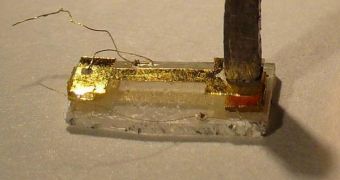Electrons are subatomic elementary particles bearing the negative electric charge inside the atom. In empty space, the motion of the electrons is largely dependent on the presence of electrical and magnetic fields, but inside matter, the way they move is directly related to the atomic arrangement of the crystal, meaning that they may behave differently depending on the type of material they're in.
The behavior of electrons in crystals can be described through a series of fundamental equations, which in the case of bismuth appear to resemble that of light, although the speed at which the electrons move is far from that of photons. The discovery was made by a team of researchers of the Princeton University's Materials Research Science and Engineering Center with the support of the National Science Foundation.
Researchers predicted more than a decade ago that electrons confined into artificial layer structures of semiconductor materials would form a new kind of electronic matter whose behavior would be determined by quantum mechanical effects generated by electrons in different layers as they coordinate their motion. At the same time, the researchers pointed out that the bismuth crystals should also exhibit analogous electronic states.
In order to prove this theory, the Princeton team created an experimental rig consisting of a flexing beam of bismuth and placed it inside an intense magnetic field, about one million times more powerful than that produced by Earth. The action of the magnetic field determined the bismuth beam to twist, suggesting that a new kind of matter is exhibited in the bismuth crystal.
Usually, in single bismuth crystals the electrons are confined to three states. However, by observing the twisting effect of the bismuth beam inside the magnetic field, the research team actually saw all electrons basically in the same state at the same time. "This is exciting because this was predicted but never shown before, and it may eventually lead to new paradigms in computing and electronics," said Thomas Rieker, NSF program director for materials research center. The findings indicate the possible existence of a high number of electronic states inside semiconductors, which could eventually lead to the creation of more powerful electronic devices working on the basis of quantum mechanical effects.

 14 DAY TRIAL //
14 DAY TRIAL //